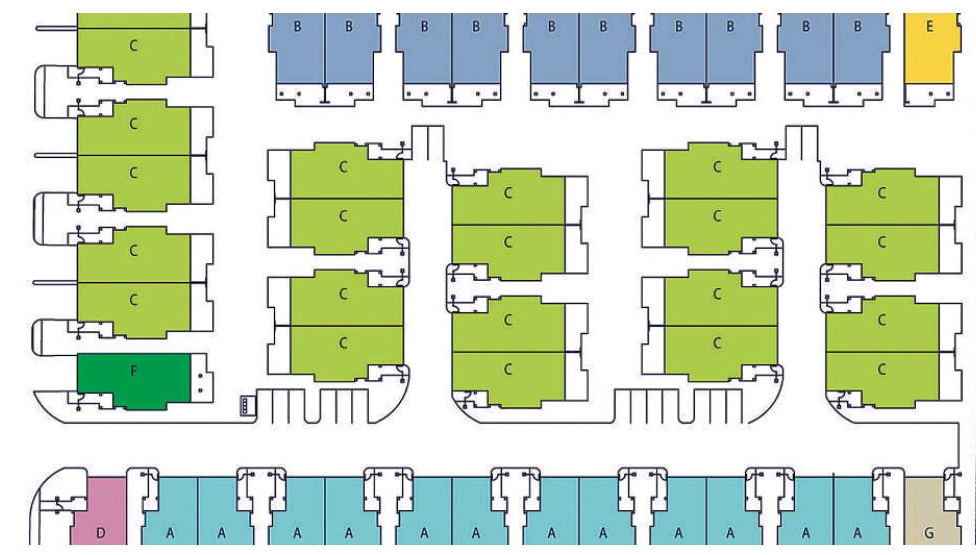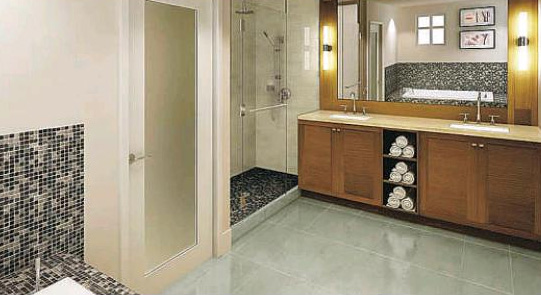Reserve plays host to luxurious homes
Michael Sasges
Sun

The Signature Estate households will reside in four differently sized townhouses. The A-plan homes at the bottom of the site plan are three-storey homes and, at about 3,000 square feet, are the largest homes in the development. The B-plan homes at the top of the site are the smallest homes.

Mosaic tile from Italy on the tub surround, porcelain tile on floors and walls and polished limestone on the vanities are among the accessory contributors to the luxury content of the ensuite display in the Signature Estate sales office. Separate tub and shower and double-bowl vanities are the principal contributors: they proclaim room to move. The Takaya development company has specified Grohe fixtures for the kitchens and bathrooms.

NEW HOMES
Project Profile
The Signature Estates at Raven Woods
Project location: Tsleil-Waututh Indian Reserve, North Vancouver
Project size: 48 townhouses
Residence size: 2,287 sq. ft. — 3,300 sq. ft., 3, 4 bedrooms
Prices: From $848,000
Sales centre location: Dollarton Highway and Raven Woods Drive, North Vancouver
Hours: noon — 5 p.m., Tue., Thurs., Sun.
Telephone: 604-929-1915
Web: ravenwoods.com
Developer: Takaya Developments
Architect: Howard Bingham Hill
Interior design: False Creek
Occupancy: December 2009
It is not wrong to locate The Signature Estates at Raven Woods on Burrard Indian Reserve #3, above the intersection of Dollarton Highway and Raven Woods Drive.
It is insufficient, however.
It is better, perhaps, to locate the Signature Estates townhouses at an intersection of aspirations.
On one approach to the intersection is the vendor, a dispossessed first nation that has “begun to reintegrate itself into the Lower Mainland economy,” in the words of the Signature Estates sales literature.
On the other are 48 individual households who will make their next home in a new-construction, low-maintenance residence at the base of Mount Seymour and at the head of Burrard Inlet, barely 15 minutes from downtown Vancouver (during off hours).
The townhouses are the 10th Raven Woods development from the Tsleil-Waututh people in almost 15 years. About 800 households reside in those nine developments.
The Signature Estate townhouses are not the first townhouses the Tsleil-Waututh have sold, but they are the first since they introduced themselves to the new-home shopper with townhouses in the ’90s.
They are also the most luxurious homes the band has ever brought to market, says Harry Wong, senior development manager of the Takaya development company.
With the smallest Signature Estates residence just under 2,300 square feet, the townhouses are big, the ultimate expression of luxury residency locally.
They will receive the commensurate steel-and-stone treatment more typically reserved for downtown and waterfront apartments: two refrigerators, for example, one of them an under-the-counter, 46-bottle wine fridge; engineered quartz on the kitchen counters; tile on the backsplashes and, in the ensuites, on the tub surrounds.
The townhouses in the inaugural Raven Woods development, in contrast, were comparatively spare because their purpose was not to attract luxury-residency buyers, but buyers, period.
“When we first started building on leasehold land and selling it to the market, we were pioneers: there was nothing like it,” Wong says.
“So we were very cautious. We were building good buildings, but we weren’t spending a lot of money on finishes. What we wanted to provide people was good value and a product that was not available in the
District of North Vancouver.”
In the subsequent eight projects, all involved in Raven Woods bumped up the exterior and interior finishes. The grounds the visitor to the Signature Estates sales centre passes are lovely, for example, not just lawn and beds, but ponds and bridges.
“Leasehold” residency is, perhaps, better known today than 15 years ago because of its role in introducing homes on the campuses of Simon Fraser University and the University of B.C.
The Queen (God Bless Her!) does not easily surrender her interest in public land. Atop Burnaby Mountain and on Point Grey, provincial law governs her largesse.
On Burrard Indian Reserve #3, federal law governs how she might admit to residency on the reserve those among us who are not registered Indians under the Indian Act.
The Queen “owns” the reserve land in trust, for the use and benefit of the Tsleil-Waututh people.
She, and the Tsleil-Waututh people, are not selling any reserve land; they are granting it to the developer, the Takaya development company, under a “head lease” of 99 years’ duration.
The developer, in turn, is selling “subleases,” the townhouses. The owners of these subleases can, in turn, ”assign” them, or sell them.
The ”head lease” rent has been prepaid by Takaya. A rent that has been prepaid is a rent that cannot change over the duration of the lease.
The Tsleil-Waututh people can cancel the head lease if the developer fails to meet its contractual obligations. (No surprise there!) But “provisions on default are oriented to remedies other than termination,” the sales literature reports.
Once the developer has built all the Signature Estate townhouses, it will transfer its head lease to a company the sales literature calls a homeowners’ corporation.
This company is the medium through which the leaseholders will exercise management of the common areas of the development. Each leaseholder will have a share in the company. Only leaseholders may serve as company directors.
It is not a strata corporation. And that’s because strata corporations are a creature of provincial legislation. On federal land in British Columbia, like Burrard Indian Reserve #3, provincial legislation like the B.C. Strata Property Act cannot apply.
Accordingly, the developer will not collect the provincial property transfer tax when it sells a townhouse.
The band, not the provincial government, will collect property taxes. The B.C. Assessment Authority will provide the assessments of value, under a contract with the band. The band will set the mill rates and they are subject to federal government approval.
Title will not be recorded in the provincial land registry, but in a federal registry in Ottawa.
The developer will collect the federal goods and services tax on the sale of the townhouses. That’s because the Tsleil-Waututh people have waived their Indian Act entitlement to tax-free purchases of goods and services on the reserve.
“The decision to forgo their inherent tax right … is a reflection of the progressive and forward-thinking nature of the Tsleil-Waututh First Nation,” the sales literature says.
—
An Industrious people — then and now
In The Signature Estates at Raven Woods sales literature, “colonial isolation” on Burrard Indian Reserve #3 is the point of departure for the Tsleil-Waututh people on their road to reintegration with the larger economy.
Here, from the annual report for the year ending March 31, 1909 of the Indian agent (a federal government official) responsible for the band, are textual manifestations of isolation for a colonial or conquest purpose. The writer was responsible for the management of six bands and was reporting on all six.
– “They keep their houses and surroundings in a sanitary condition, and most of them have been vaccinated.”
– “They are engaged chiefly in hunting, fishing, logging and loading lumber in ships at the sawmills. They also do some farming and gardening.”
– “Their houses are well constructed frame buildings. They have some good stock, and a fair supply of farm implements.”
– “They are industrious people and are making satisfactory progress.”
– “Some of them are fond of liquor, but they are strictly moral.”
Also in 1908, and according to vancouver.ca on the Web:
– Members of the B.C. Mountaineering Club made the first known ascent of Mount Seymour.
– The first North Shore hospital opened, a six-bed facility at St. Andrews and 15th Street.
– A developer cleared and constructed Grand Boulevard and conveyed it to the City of North Vancouver to encourage development. More than two dozen residences on the city’s heritage inventory have Grand Boulevard addresses.
—
Peaking interest
Among the many architectural styles that might inspire the look and feel of a new home or a new-home community on the North Shore are two that were nurtured locally. One is called West Coast Modern. The other might be called Alpine Rustic or Mountain Rustic.
Bringing the outdoors inside
The Signature Estate townhouses will broadcast Mountain Rustic influences.
Their roofs especially speak of a robust possession of a higher-elevation site on the windward, storm-lashed side of the Coast Mountains or the North Cascades.
Their pitches will begin the movement of water away from the buildings with dispatch.
Their numbers and intersections will eliminate those long expanses, across roof and facade, that stop the full fury of a Pacific storm at a structure. The Signature Estate roofs will deflect it.
The same architectural practice, Howard Bingham Hill, has designed all 10 Raven Woods developments.

